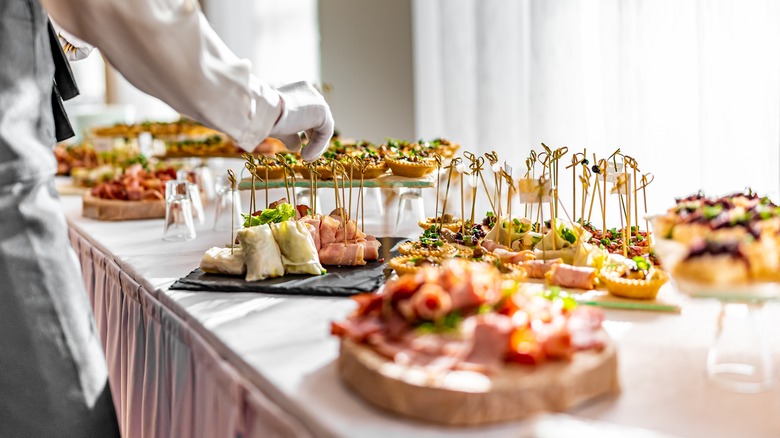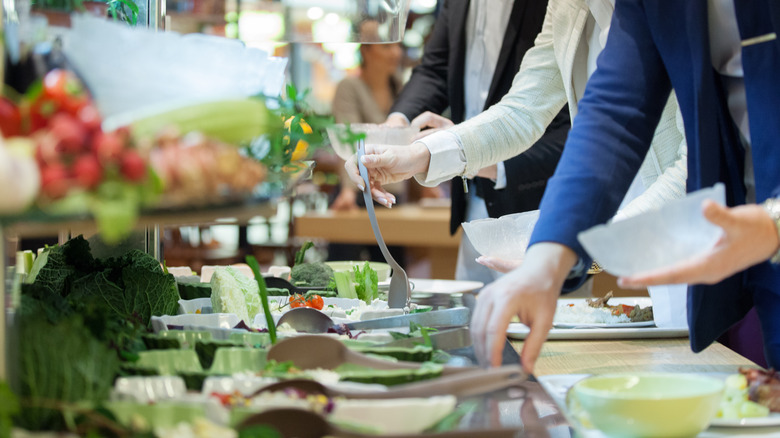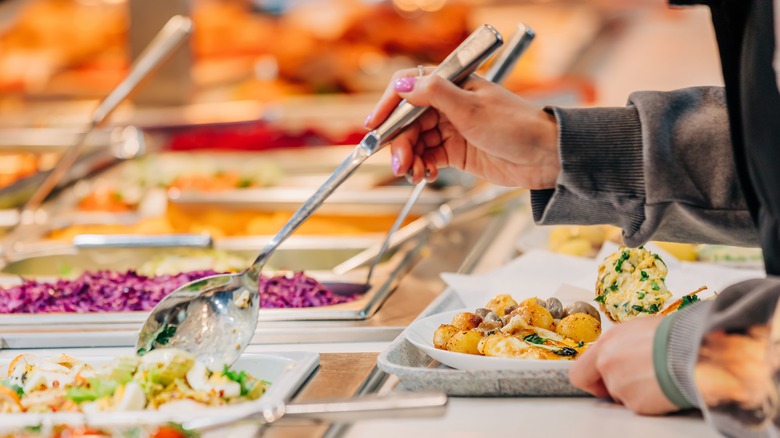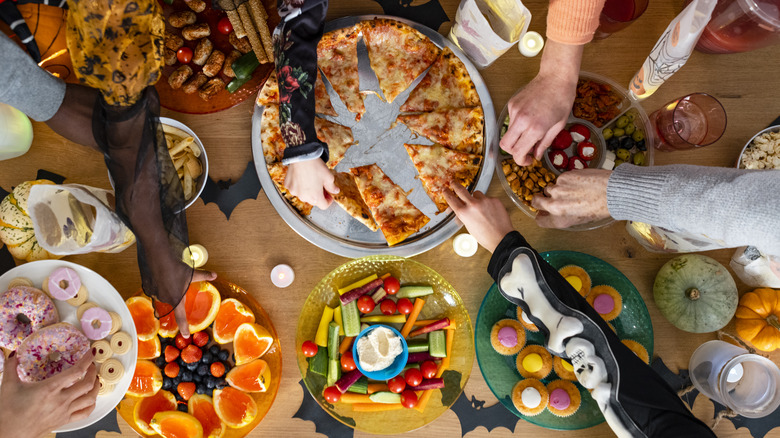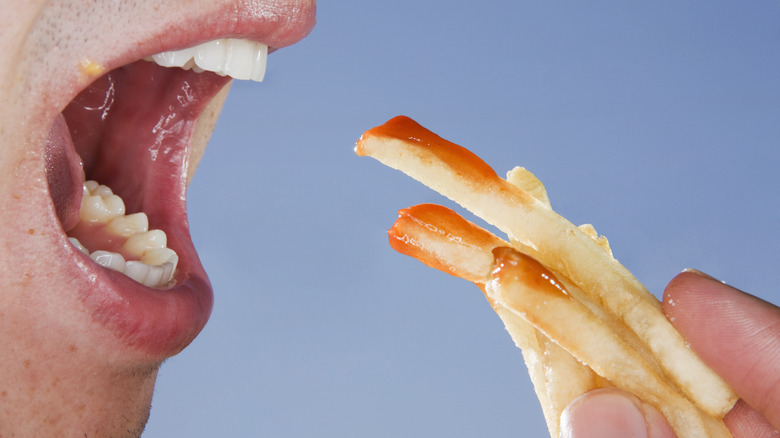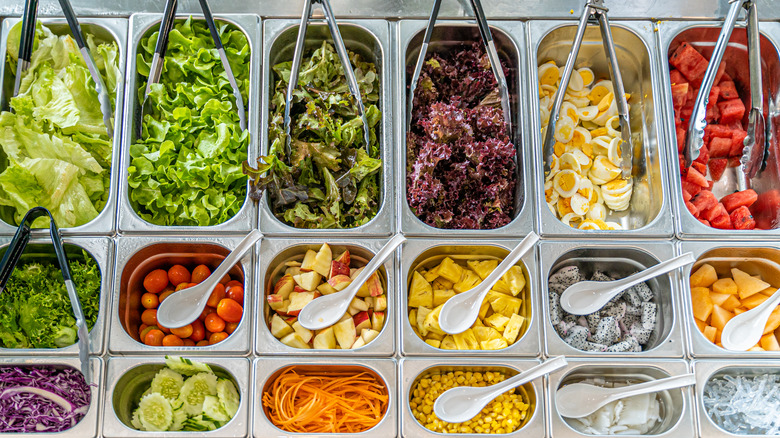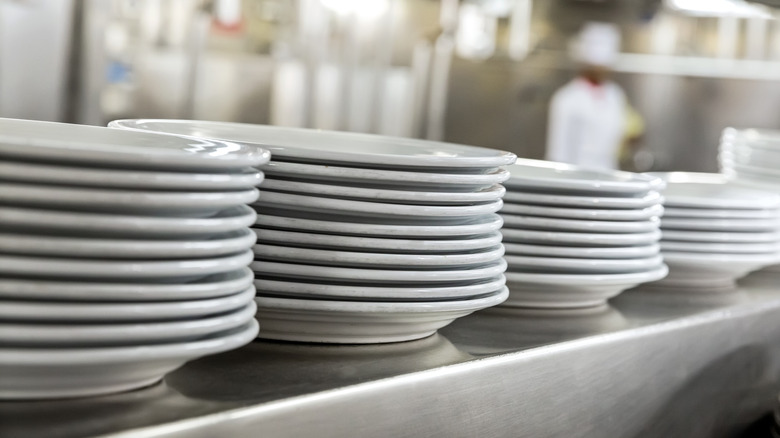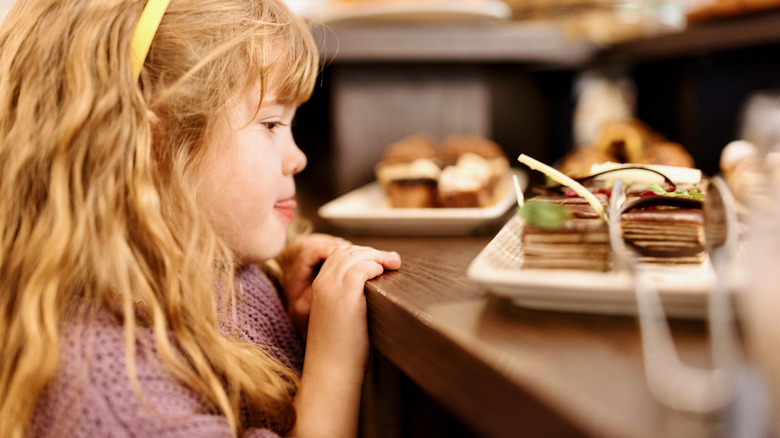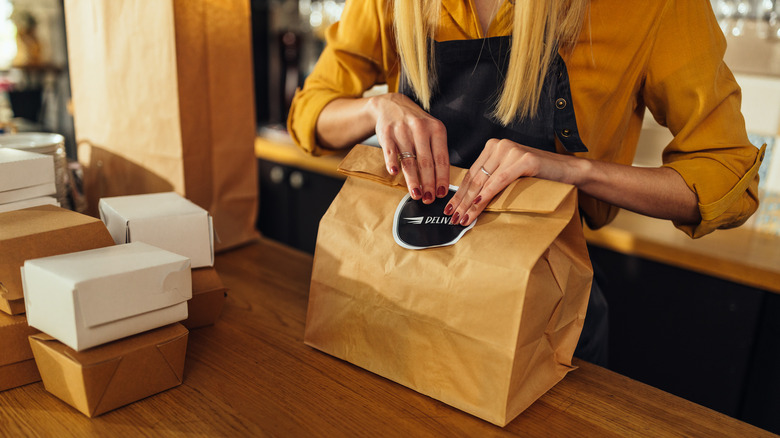Etiquette Rules You Should Always Follow At An All-You-Can-Eat Buffet
There is a special kind of dining experience that comes with all-you-can-eat buffets. While the origins may be with the Swedes, buffets have been an American staple since the early 1900s. And, since then, they've created a culture all their own. From some of the best buffet restaurants found within the United States to cruise line dining rooms and casino spreads, all have a set of etiquette rules they unofficially employ.
Unlike fine dining rules that can make no sense at all, buffet etiquette is pretty cut and dry. There is a clear purpose to all of the unspoken guidelines surrounding the buffet table; namely, to keep cleanliness up and unruliness down. The very nature of a buffet is fill up on a large meal at low prices, but while there are plenty of buffet hacks to really get your money's worth, it's wise not to sacrifice tact and etiquette for getting the most bang for your buck.
Instead, take ownership of these simple, yet effective guidelines for dining at an all-you-can-eat buffet to make the most of the experience for you and everyone else.
No cuts or butts
The golden rule of all lines is really just to stick to your spot. Most of us learn this as early as preschool, but some adults still choose to break the rule of keeping their place in line. And it's really not fair to anyone you are cutting in front of since everyone is hungry and waiting patiently in the queue.
Buffets are particularly rude to butt into, because one person can be the difference in missing out on a desired item. No one wants to see the very last crab leg or cream puff taken right before they get the opportunity to grab it — especially if they were supposed to get there first. This rule goes for saving spots as well. There are no holds in a buffet line, so don't let your latecomer partner and kids step in front of you without expecting the ire of everyone behind you.
There are a couple key exceptions to this golden rule, though. If you have already been through the line once and want to go back for a single item, feel free to insert yourself into the line wherever that one item is. The other exception is if the person in front of you is taking their sweet time choosing and holding the line up; in this case, you can go around the indecisive diner if there is plenty of space and you're quick.
Save eating for the table
At any buffet, sitting at your table with a huge plate of food is the end goal, but it's best not to put food in your mouth until you reach that pinnacle moment. It may seem pertinent to taste the goods before committing to putting them on your plate, but refrain from doing so while in the buffet line. Instead, put a little on your plate and go back for more if you enjoy the dish. The beauty of buffets is that they are a FOMO-free zone.
Not only could this taste testing hold up the line, but it's actually pretty gross. Even if you're careful and use a clean fork, you can very well contaminate the food with your own spit. Your saliva could easily get in the spread of food when you open your mouth to eat, especially if you're talking. Just as much as you don't want someone's mouth juice in your food, pay it forward and make sure yours stays where it belongs too.
Use utensils, not your hands
Could you imagine seeing some delectable fried mac and cheese bites waiting down the buffet line, only for a person ahead of you to grab one with their bare hands? It's pretty off-putting, and it makes you wonder what else on your plate has been touched by someone's grubby paws. Each dish has its own serving utensils for a reason, so use them and refrain from touching any food or the food-facing ends of the utensils with your hands. (On that note, you should also wash your hands before hitting the buffet line.)
Another good idea for practicing proper buffet etiquette is putting the utensils back in their designated spaces. If the various spoons and tongs aren't where they are supposed to be, people will naturally be less likely to use them. They will then be forced to either use their hands or another dish's serving utensil, which will then mix separate flavors together and create an all-around icky situation. You never know if someone could be avoiding a certain dish due to an allergy as well, so utensils always need to stick to their own dish.
If you touch it, take it
One of the gross things about eating at a buffet is that some of the food may have been touched by other diners. Seeing another person touch and take an item, though, is a whole lot better than seeing them touch and leave an item.
After all, everyone wants to go into a buffet with the confidence that the items on their plate have not been touched. While this may not actually be the reality, the illusion of cleanliness is all a part of the magical buffet experience. So, if you do accidentally touch a food item, remove it from the communal dish and put it on your plate.
What is even worse is when diners return food to the buffet dish from their plate. It may see obvious, but if you take it, please keep it. Once an item is on your plate, it is claimed and is yours to either eat or throw out.
Watch your mouth
While you're in the buffet line, try to keep your mouth closed. That means refraining from yawning, coughing, or sneezing. If you can't help it, make sure to cover your mouth, sneeze into your elbow, and change your direction when coughing to face away from the food. If you know you are sick, it's probably best to stay home and hold off on going out to a buffet until you're not a risk to other people. If you start not feeling well at dinner, have someone else load up your plate to avoid having buffet dishes become contaminated with whatever bacteria or virus you may have.
A buffet usually has a sneeze guard to help protect the food from, well, sneezes (and it may be a sign of a bad buffet if there isn't one). This sheet of plastic is a last line of defense, though, and you should always be actively attempting to get through the buffet line without spraying any saliva or germs. This guard is also there to deter people from putting their faces too close to the food, so it's best to respect that boundary and don't duck your head underneath it.
Keep it tidy
It may be the buffet staff's job to help keep everything stocked and looking nice, but it's also your responsibility to do the same as a diner. Each individual buffet goer should take ownership of their own small part they play in the buffet process. Try to keep the food where it belongs, with spills at a minimum. Accidents happen, of course, but in the few seconds it takes you to scope out a dish, try to leave the space as tidy as you found it so that everyone else in line has a decent experience.
While you're focused on not spilling or dropping anything on the buffet, it's also wise to pay attention to more than just your hands. Watch out for your clothes or jewelry as you reach across dishes to serve yourself. Long, flowy sleeves or a loose bracelet could fall or dip into a serving platter. Not only will this contaminate the entire spread, but a food-covered sleeve isn't exactly ideal either.
Use fresh plates when going back for more
Maybe you think that you're doing the restaurant a favor or being eco-conscious by reusing your buffet plate. Or maybe you consider it high maintenance to get a new one each time you approach the buffet. But none of these scenarios are true, and it's actually frowned upon to not use a clean plate for each and every round of food gathering.
There is a large amount of bacteria on your used plate, from silverware entering your mouth and then touching the plate, and leaving your dirty plate behind helps lessen the risk of contamination.
The buffet area should have towering piles of plates anyway. If they are in short supply, though, it's better to ask a staff member for more clean plates than it is to revert back to the one you've already used.
Don't be wasteful
Buffets are all-you-can-eat, but before grabbing a lot of everything just because you can, make sure you can actually handle that big amount of food. There's absolutely nothing wrong with loading your plate up, but that is only if your mouth is just as big as your eyes. If you take 13 shrimp pieces, be prepared for every single one to take passage through your gullet.
At the heart of the matter, though, there really is no reason to take so much at one time. The great thing about a buffet is that there is no rush or sense of urgency, and you can go up to get more food practically as many times as you want.
In fact, putting a lot of one food item on your plate may end up hurting you in the long run. If your plate is full of appetizers before you get to the main course, you may be too full to enjoy later rounds. Scoping out the buffet before getting in line is a great way to avoid this situation. This allows you to gauge and balance what you want to eat with what you are capable of eating. It's also good to note that if you do end up with a lot of wasted food, you may even be charged a fee.
Keep up with the kids in your group
Buffets can be a great way to introduce kids to different foods and to fill up their bellies affordably. However, like all restaurants, a buffet should have some safety guidelines where children aren't running around, weaving in and out of people trying to get their plates to their seats.
Not only is it frustrating to dodge little humans who are sometimes hard to see, but it can be dangerous. Knocking into someone carrying hot food could result in some serious burns to both parties, too.
If you children are maybe too young to go through the buffet line themselves, it's best to fill their plate for them. This helps keep the line moving, and it's more sanitary since kids aren't as knowledgeable about food safety and cleanliness.
Don't take all the good stuff
In all-you-can-eat scenarios, you can of course take as much of a dish as your heart desires. However, it's good to give some thought for the next guy and refrain from loading up your plate with the last ten sets of crab legs. If you see a serving platter only has a few pieces of an item left, don't empty it. This is an extra important rule if the item in question is a popular, well sought-after dish.
On the other hand, there might be quite a lot of a food item left when you get to it. It's still kind of questionable if you should load up on it or not. If the buffet isn't crowded, you may be able to get away with this without coming off as inconsiderate. However, if there is a long line behind you, let some others have their chance at the dish, too. There will be fresh plates coming, and you can return to the line for seconds when they do.
Don't be a lurker
Restaurant etiquette goes a long way in remaining polite while in close quarters with other hungry people. If you're in the buffet line, it's best to maintain some personal space like you would do in other crowded scenarios. While it's okay to wait patiently for a dish that someone else is currently interacting with, keep a respectful distance and do not lurk closely behind them.
If they're taking longer than you'd like, simply wait your turn with a smile (after all, they have been waiting too). Also, when it comes to looking for more food to come out of the kitchen, it's good to maintain that same patience rather than swooping in like a hawk to its prey once the food does hit the buffet line.
Lurking can apply to the restaurant experience as a whole as well. Believe it or not, buffets sometimes have time limits, or even food limits. You can actually be kicked out of a buffet for eating too much. Check the guidelines before starting to nosh to be sure to understand the expectations.
Go with the flow
Buffets are typically a one-way operation, and it's frowned upon to go against the flow of hungry people traffic. When you buck against the directional flow of the buffet line, chaos ensues. Humans are like herd animals, after all, and if onr person goes against the grain, others are bound to follow. Can you imagine one group of people starting at the salads and another beginning at the desserts, clashing as a starved mob at the meats and veggies? It's utter madness!
Buffet employees have the plates and dishes set up strategically as well, and it throws a wrench in their plan to go rogue. If there are no dinner plates where you're starting, that's your hint that you're probably at the wrong end of the buffet to start.
You should also refrain from doubling back at any point. You can always get back in line or go up for single items, but once you pass by a dish, you've basically relinquished your right to it in line. When you start crossing arms with other diners, the chances of contaminating the food with accidental spills and touches increases. Plus, there's really no good reason to reach into another person's space.
No to-go boxes
Buffets may be all-you-can-eat, but the metaphorical fine print specifies that you must eat all you can while in the actual restaurant. As cost-effective as it would be to be able to have a hefty dinner and load up a to-go box with tomorrow's lunch, that's just not how it works. Almost all buffet-style restaurants do not set out boxes at all for this reason, and would be hesitant to give you one if specifically asked. Some diners try to sneak in their own containers, but this comes with risks. It can actually be considered theft, and you could be charged a fee, kicked out, or even added to the banned customers list.
If you do end up obtaining a takeout box from a staff member, you will almost certainly be charged a fee. Some buffets do have takeout deals, which are either charged by the pound or by the box. Other times, a box from the buffet would cost the same as your individual entrance fee. This makes sense if you don't want to dine in or are getting food to-go for a family member not present, but may be a stretch for taking home leftovers.
Be polite to staff
While it's always good to be extra nice to service workers, this goes double for people who are handling your food. A buffet-style restaurant offers a bit less face-to-face interaction with staff, but you're still likely to see them around and have some slight conversation with them.
A buffet has a lot of moving parts, so there is typically more staff around than a full service spot. This means that your service staff are working hard to communicate with each other to give the best service and experience possible, so please be appreciative of their efforts. This can be as simple as minding your Ps and Qs and leaving a tip.
If you happen to come across a food item that needs refilling, ask the staff nicely about replenishing the plate. Once you are finished with your plates, set them to the side for a server to come collect. Upon cashing out, 10% is largely considered to be an appropriate buffet tip — keep in mind that this tip is likely shared with other staff members such as bussers too.
